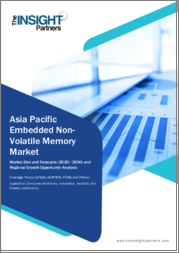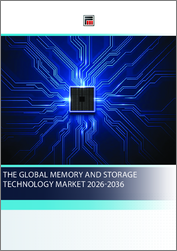
|
시장보고서
상품코드
1533176
아시아태평양의 임베디드 비휘발성 메모리 시장 예측(-2030년) : 지역별 분석 - 제품별, 용도별Asia Pacific Embedded Non-Volatile Memory Market Forecast to 2030 - Regional Analysis - by Product (eFlash, eE2PROM, FRAM, and Others) and Application (Consumer Electronics, Automotive, Robotics, and Others) |
||||||
아시아태평양의 임베디드 비휘발성 메모리 시장은 2022년 2억 9,206만 달러로 평가되며, 2030년에는 16억 2,179만 달러에 달할 것으로 예상되며, 2022년부터 2030년까지 23.9%의 CAGR로 성장할 것으로 예상됩니다.
저전력 IoT 모듈에 대한 수요 증가로 아시아태평양의 임베디드 비휘발성 메모리 시장 성장 전망
세계의 기술 대기업들은 새로운 기술 연구개발에 많은 노력을 기울이고 있으며, IoT는 임베디드 비휘발성 메모리 시장에서 차세대 소프트웨어 기술의 핵심으로 자리매김하고 있습니다. 임베디드 비휘발성 메모리는 IoT 분야에서 폭넓게 활용되고 있습니다. 임베디드 비휘발성 메모리는 사용자가 향후 의사결정 활동을 위해 데이터를 수집하고 저장하는 데 사용됩니다. 임베디드 비휘발성 메모리는 저전력 IoT 모듈을 지원할 수 있으며, IoT 모듈의 출하량 증가는 임베디드 비휘발성 메모리 시장에 박차를 가하고 있습니다. 예를 들어, 2023년 1분기 Telit Cinterion, Quectel, Fibocom 등의 기업은 저전력 NB-IoT 및 LTE-M(Cat-M) 모듈의 출하량을 늘렸습니다. 내장 비휘발성 메모리는 모듈의 전압을 조정하기 위한 온칩 및 오프칩의 필요성을 줄여 추가 공간과 비용을 절감하고 IoT 모듈을 지원하며, IoT 모듈은 초저전력 동작 및 소형화 문제를 해결하기 위해 IoT 에지 및 엔드포인트 장치에서 가장 많이 사용되고 있습니다. IoT 모듈은 독립적으로 작동하면서 클라우드에 연결하고, 데이터 패킷을 교환하고, 펌웨어를 일괄적으로 다운로드할 수 있으며, IoT 엣지 장치 및 엔드포인트 장치에서 가장 일반적으로 사용됩니다. 이러한 모듈은 작동을 위해 높은 에너지와 전력을 필요로 하기 때문에 사용자들 사이에서 임베디드 비휘발성 메모리에 대한 수요가 증가하고 있습니다. 또한, 초저전력 IoT 모듈에 대한 수요가 증가함에 따라 시장 기업들은 동작에 필요한 전력이 적은 혁신적인 임베디드 비휘발성 메모리를 개발하기 위해 노력하고 있습니다. 예를 들어, ST마이크로일렉트로닉스는 지난 6월 EEPROM(Electrically Erasable Programmable Read-Only Memory) 시리즈를 출시해 저전력 에너지로 효과적으로 작동하는 임베디드 시스템 및 소형 IoT 모듈을 지원합니다. EEPROM 시리즈는 저전력 에너지로 효과적으로 작동하는 임베디드 시스템 및 소형 IoT 모듈을 지원하는 새로운 고밀도 올인원 임베디드 비휘발성 메모리 제품군으로, 효율적인 데이터 로깅, 빠른 업로드/다운로드, 초저전력 소비로 모듈 효율을 높이고 전력 소비를 최소화하는 등 여러 가지 이점을 제공합니다. IoT의 광범위한 도입이 시장 성장을 주도하고 있는 가운데, EEPROM 시리즈는 사용자에게 몇 가지 이점을 제공합니다. 예를 들어, 시스코 비주얼 네트워킹 인덱스(Cisco Visual Networking Index)에 따르면, 2022년에는 임베디드 시스템에서 활성화되고 IoT에 의해 구동되는 네트워크 장치가 280억 개가 넘을 것으로 예상됩니다. 네트워크 장비는 사용자가 연결성과 보안을 개선하고 비즈니스의 추가 운영 비용을 절감하는 데 도움이 될 수 있습니다. 임베디드 시스템과 IoT 기기 및 플랫폼의 통합은 스마트홈, 스마트 시티, 산업용 IoT 등의 분야에서 새로운 용도와 서비스를 가능하게 하고 있습니다. 또한, 스마트 시티 및 스마트 홈 프로젝트가 확대됨에 따라 IoT 기반 임베디드 시스템에서 임베디드 비휘발성 메모리에 대한 수요가 증가할 것으로 예상되며, 이는 시장 성장의 기회가 될 것으로 보입니다.
아시아태평양 임베디드 비휘발성 메모리 시장 개요
아시아태평양 임베디드 비휘발성 메모리 시장은 중국, 인도, 호주, 일본, 한국 및 기타 아시아태평양 국가로 분류됩니다. 아시아태평양의 임베디드 비휘발성 메모리 시장의 성장에는 대규모 산업화, 낮은 인건비, 유리한 경제 정책, 적극적인 경제 개발, 외국인 직접 투자(FDI) 및 외국인 기관 투자(FII)의 증가 등이 기여하고 있습니다. 대만과 중국은 아시아태평양의 주요 반도체 제조국입니다. 신흥국 정부는 '메이드 인 차이나 2025', '메이드 인 인디아'와 같은 전략적 이니셔티브를 통해 자국 내 수요를 충족하고 잉여 물량을 수출할 수 있도록 국내 제조업의 성장을 촉진하고 있습니다. 또한, 인도와 중국 등 신흥국의 1인당 GDP 증가는 스마트 웨어러블, 가전제품, 전기자동차, 스마트폰 등 첨단 가전제품에 대한 대규모 고객층으로 이어지고 있습니다. 많은 아시아 경제는 가전제품, 통신 장비, 자동차 부품 및 기타 산업 기계에 필요한 전자부품 및 장치의 대량 생산이 특징입니다. 에릭슨의 모빌리티 보고서에 따르면, 아시아태평양의 모바일 연결은 2021년 말까지 40억에서 46억으로 증가할 것으로 예상됩니다. 스마트폰 및 기타 첨단 인터넷 지원 기기의 보급은 아시아태평양 임베디드 비휘발성 메모리에 대한 수요를 증가시킬 것으로 예상됩니다. 또한, 아시아태평양은 스마트폰의 최대 소비시장으로 2019년에는 약 7억 3,200만 대의 스마트폰이 아시아태평양 소비자들에 의해 구매되었습니다. 통신 부문은 5G 네트워크 도입에 대한 긍정적인 전망과 4G 네트워크의 강력한 존재감으로 인해 아시아태평양에서 강력한 성장을 목격하고 있습니다. 에릭슨의 모빌리티 보고서에 따르면 2026년까지 서아시아와 동북아시아가 전체 5G 도입의 66%를 차지하고 동남아와 오세아니아가 32%의 점유율을 차지할 것이며, 나머지 점유율은 LTE(4G) 기술이 차지할 것입니다. 이 지역은 자동차 산업이 발달한 지역으로 인도, 한국 등에서는 자동차 제조업이 성장하고 있습니다. 중국, 인도, 한국, 일본 등은 세계 최고의 자동차 제조국입니다. 예를 들어 인도는 2020년에 339만 4,446대의 자동차를 생산했고, 그 중 293만 8,653대가 판매되었습니다. 또한 2020년 중국은 2,522만 5,242대를 생산해 2,531만 1,069대를 판매해 세계 최대 자동차 생산국이 됐습니다. 또한, 이 지역 정부는 자동차 산업의 성장을 지원하기 위해 다양한 노력을 기울이고 있습니다. 예를 들어, 2019년 인도 정부는 자동차 부문이 세계 표준을 충족할 수 있도록 3억 8,850만 달러 상당의 R&D 센터를 설립할 계획을 발표했습니다.
아시아태평양 임베디드 비휘발성 메모리 시장 매출 및 2030년까지의 예측(금액)
아시아태평양 임베디드 비휘발성 메모리 시장 세분화
아시아태평양 임베디드 비휘발성 메모리 시장은 제품, 용도, 국가별로 세분화됩니다. 제품별로 아시아태평양 임베디드 비휘발성 메모리 시장은 eFlash, eE2PROM, FRAM, 기타로 분류되며, eFlash 부문이 2022년 가장 큰 시장 점유율을 차지했습니다.
용도별로 아시아태평양의 임베디드 비휘발성 메모리 시장은 가전, 자동차, 로봇, 기타로 분류됩니다. 2022년에는 기타 부문이 가장 큰 시장 점유율을 차지했습니다.
국가별로 아시아태평양의 임베디드 비휘발성 메모리 시장은 중국, 일본, 한국, 인도, 호주, 기타 아시아태평양으로 구분되며, 2022년 아시아태평양의 임베디드 비휘발성 메모리 시장 점유율은 중국이 독식했습니다..
Microchip Technology Inc, Tower Semiconductor, GlobalFoundries Inc, eMemory Technology Inc, Texas Instruments Inc, Hua Hong Semiconductor Ltd, Taiwan Semiconductor Manufacturing Co Ltd, United Microelectronics Corp, Semiconductor Manufacturing International Corp, Synopsys Inc는 아시아태평양의 임베디드 비휘발성 메모리 시장에서 사업을 전개하고 있는 주요 기업입니다.
목차
제1장 소개
제2장 주요 요약
- 주요 인사이트
- 시장 매력
제3장 조사 방법
- 조사 범위
- 2차 조사
- 1차 조사
제4장 아시아태평양의 임베디드 비휘발성 메모리 시장 상황
- 생태계 분석
- 밸류체인 벤더 리스트
제5장 아시아태평양의 임베디드 비휘발성 메모리 시장 : 주요 산업 역학
- 성장 촉진요인
- 가정용 전자기 보급 확대
- 자동차 산업 확대
- 성장 억제요인
- 세계의 반도체 칩 부족
- 기회
- 저소비 전력 IoT 모듈 수요 증가
- 동향
- 임베디드 비휘발성 메모리 상업화에 대한 투자 확대
- 성장 촉진요인과 억제요인의 영향
제6장 임베디드 비휘발성 메모리 시장 : 아시아태평양 시장 분석
- 임베디드 비휘발성 메모리 시장 판매량, 2022-2030년
- 임베디드 비휘발성 메모리 시장 예측과 분석
제7장 아시아태평양의 임베디드 비휘발성 메모리 시장 분석 : 제품별
- eFlash
- eE2PROM
- FRAM
- 기타
제8장 아시아태평양의 임베디드 비휘발성 메모리 시장 분석 : 용도별
- 가정용 전자기
- 자동차
- 로봇
- 기타
제9장 아시아태평양의 임베디드 비휘발성 메모리 시장 : 국가별 분석
- 중국
- 일본
- 한국
- 인도
- 호주
- 기타 아시아태평양
제10장 경쟁 상황
- 주요 기업별 히트맵 분석
제11장 업계 상황
- 시장 이니셔티브
- 신제품 개발
- 인수합병
제12장 기업 개요
- Microchip Technology Inc
- Tower Semiconductor
- Globalfoundries Inc
- eMemory Technology Inc.
- Texas Instruments Inc
- Hua Hong Semiconductor Limited
- Taiwan Semiconductor Manufacturing Co Ltd
- United Microelectronics Corp
- Semiconductor Manufacturing International Corp
- Synopsys Inc
제13장 부록
ksm 24.09.20The Asia Pacific embedded non-volatile memory market was valued at US$ 292.06 million in 2022 and is expected to reach US$ 1,621.79 million by 2030; it is estimated to grow at a CAGR of 23.9% from 2022-2030.
Increasing Demand in Low-Power IoT Modules Boosts Asia Pacific Embedded Non-Volatile Memory Market
Technological giants worldwide are highly focused on research and development of new technologies. IoT is positioned at the core of the next-gen software technologies in the embedded non-volatile memory market. Embedded non-volatile memory has a wide range of applications in the IoT sector. They are used to collect and store data to help users perform future decision-making activities. An embedded non-volatile memory is capable of supporting low-power IoT modules. The growing shipment of IoT modules is fueling the embedded non-volatile memory market. For instance, in the first quarter of 2023, companies such as Telit Cinterion, Quectel, and Fibocom increased the shipment of low-power NB-IoT and LTE-M (Cat-M) modules. Embedded non-volatile memory supports IoT modules by saving additional space and cost by reducing the need for on- and off-chip to regulate the voltage of the modules. IoT modules are most commonly used in IoT edge or endpoint devices for solving challenges related to ultra-low power operation and shrinking size. IoT modules can connect to the cloud, exchange data packets, and download firmware in batches while operating independently. These modules require high energy and power to perform operations, which increases the demand for embedded non-volatile memory among users. Furthermore, the growing demand for ultra-low power consumption IoT modules encourages market players to develop new innovative embedded non-volatile memory that requires low power to perform operations. For instance, in June 2022, STMicroelectronics launched the Electrically Erasable Programmable Read-Only Memory (EEPROM) series. The EEPROM series is a new high-density, all-in-one embedded non-volatile memory family that supports embedded systems and tiny IoT modules to operate effectively in low-power energy. The EEPROM series offers several benefits to the user, including efficient data logging, fast upload/download, and ultra-low power for enhancing module efficiency while minimizing power dissipation. The extensive adoption of IoT is fueling the market growth. For instance, according to the Cisco Visual Networking Index, in 2022, there were more than 28 billion network devices enabled with embedded systems and powered by IoT. The network devices help users improve connectivity and security and reduce additional operational costs for the business. The integration of embedded systems with IoT devices and platforms is enabling new applications and services in areas such as smart homes, smart cities, and industrial IoT. Also, the expansion of smart cities and smart home projects is anticipated to increase the demand for embedded non-volatile memory in IoT-based embedded systems, thereby providing opportunities for the market growth.
Asia Pacific Embedded Non-Volatile Memory Market Overview
The embedded non-volatile memory market in APAC is segmented into China, India, Australia, Japan, South Korea, and the Rest of APAC. Vast industrialization, low labor cost, favorable economic policies, positive economic development, and an increase in foreign direct investments (FDIs) and foreign institutional investments (FIIs), among others, contribute to the growth of the APAC embedded non-volatile memory market. Taiwan and China are the leading semiconductor manufacturing countries in APAC. The governments of emerging economies have been taking strategic initiatives, such as Made in China 2025 and make in India, to promote the growth of the domestic manufacturing sectors for making the respective countries capable of meeting the native demands and exporting surplus goods. Moreover, the rising GDP per capita in developing countries, such as India and China, leads to a large client base for high-tech consumer electronics such as smart wearables, appliances, electric vehicles, and smartphones. Many Asian economies are characterized by the mass production of electronic components or devices required for consumer electronics, telecommunication devices, automotive components, and other industrial machinery. As per the Ericsson Mobility Report, their mobile connections in APAC are expected to rise from ~4 billion to 4.6 billion by the end of 2021. An increase in the adoption of smartphones and other advanced internet-enabled devices is anticipated to boost the demand for embedded non-volatile memory in APAC. Moreover, APAC is the biggest consumer of smartphones, as ~732 million units were bought by consumers in 2019. The telecommunication sector is witnessing strong growth in Asia Pacific mainly due to the positive outlook toward introducing 5G networks and the strong presence of 4G networks. According to Ericsson's mobility report, Western and Northeast Asia would account for 66% share of the total 5G adoption by 2026, while Southeast Asia and Oceania would hold 32% share by 2026; the rest of the shares would be held by the LTE (4G) technology. The region has a robust automotive sector, which is followed by the growing automotive manufacturing industry in countries such as India and South Korea. Countries such as China, India, South Korea, and Japan are among the leading vehicle manufacturing countries worldwide. For instance, India produced 3,394,446 vehicles, of which 2,938,653 were sold in 2020. Also, in 2020, China was the largest vehicle-producing country globally; it produced 25,225,242 vehicles in 2020, of which 25,311,069 were sold. Moreover, the governments in this region are undertaking various initiatives to support the automotive industry's growth. For instance, in 2019, the government of India announced its plan to set up research and development centers worth US$ 388.5 million to enable the automotive sector to meet global standards.
Asia Pacific Embedded Non-Volatile Memory Market Revenue and Forecast to 2030 (US$ Million)
Asia Pacific Embedded Non-Volatile Memory Market Segmentation
The Asia Pacific embedded non-volatile memory market is segmented based on product, application, and country. Based on product, the Asia Pacific embedded non-volatile memory market is categorized into eFlash, eE2PROM, FRAM, and others. The eFlash segment held the largest market share in 2022.
In terms of application, the Asia Pacific embedded non-volatile memory market is categorized into consumer electronics, automotive, robotics, and others. The others segment held the largest market share in 2022.
Based on country, the Asia Pacific embedded non-volatile memory market is segmented into China, Japan, South Korea, India, Australia, and the Rest of Asia Pacific. China dominated the Asia Pacific embedded non-volatile memory market share in 2022.
Microchip Technology Inc, Tower Semiconductor, GlobalFoundries Inc, eMemory Technology Inc, Texas Instruments Inc, Hua Hong Semiconductor Ltd, Taiwan Semiconductor Manufacturing Co Ltd, United Microelectronics Corp, Semiconductor Manufacturing International Corp, and Synopsys Inc are some of the leading companies operating in the Asia Pacific embedded non-volatile memory market.
Table Of Contents
1. Introduction
- 1.1 The Insight Partners Research Report Guidance
- 1.2 Market Segmentation
2. Executive Summary
- 2.1 Key Insights
- 2.2 Market Attractiveness
3. Research Methodology
- 3.1 Coverage
- 3.2 Secondary Research
- 3.3 Primary Research
4. Asia Pacific Embedded Non-Volatile Memory Market Landscape
- 4.1 Overview
- 4.2 Ecosystem Analysis
- 4.2.1 List of Vendors in Value Chain:
5. Asia Pacific Embedded Non-Volatile Memory Market - Key Industry Dynamics
- 5.1 Drivers
- 5.1.1 Increase in Adoption of Consumer Electronics
- 5.1.2 Expansion of Automotive Industry
- 5.2 Restraints
- 5.2.1 Global Shortage of Semiconductor Chips
- 5.3 Opportunities
- 5.3.1 Increasing Demand in Low-Power IoT Modules
- 5.4 Trends
- 5.4.1 Growing Investment in Commercialization of Embedded Non-Volatile Memory
- 5.5 Impact of Drivers and Restraints:
6. Embedded Non-Volatile Memory Market - Asia Pacific Market Analysis
- 6.1 Embedded Non-Volatile Memory Market Revenue (US$ Million), 2022 - 2030
- 6.2 Embedded Non-Volatile Memory Market Forecast and Analysis
7. Asia Pacific Embedded Non-Volatile Memory Market Analysis - Product
- 7.1 eFlash
- 7.1.1 Overview
- 7.1.2 eFlash Market Revenue and Forecasts to 2030 (US$ Million)
- 7.2 eE2PROM
- 7.2.1 Overview
- 7.2.2 eE2PROM Market Revenue and Forecasts to 2030 (US$ Million)
- 7.3 FRAM
- 7.3.1 Overview
- 7.3.2 FRAM Market Revenue and Forecasts to 2030 (US$ Million)
- 7.4 Others
- 7.4.1 Overview
- 7.4.2 Others Market Revenue and Forecasts to 2030 (US$ Million)
8. Asia Pacific Embedded Non-Volatile Memory Market Analysis - Application
- 8.1 Consumer Electronics
- 8.1.1 Overview
- 8.1.2 Consumer Electronics Market Revenue and Forecasts to 2030 (US$ Million)
- 8.2 Automotive
- 8.2.1 Overview
- 8.2.2 Automotive Market Revenue and Forecasts to 2030 (US$ Million)
- 8.3 Robotics
- 8.3.1 Overview
- 8.3.2 Robotics Market Revenue and Forecasts to 2030 (US$ Million)
- 8.4 Others
- 8.4.1 Overview
- 8.4.2 Others Market Revenue and Forecasts to 2030 (US$ Million)
9. Asia Pacific Embedded Non-Volatile Memory Market - Country Analysis
- 9.1 Asia Pacific Embedded Non-Volatile Memory Market
- 9.1.1 Overview
- 9.1.2 Embedded Non-Volatile Memory Market Breakdown by Countries
- 9.1.2.1 China Embedded Non-Volatile Memory Market Revenue and Forecasts to 2030 (US$ Mn)
- 9.1.2.1.1 China Embedded Non-Volatile Memory Market Breakdown by Product
- 9.1.2.1.2 China Embedded Non-Volatile Memory Market Breakdown by Application
- 9.1.2.2 Japan Embedded Non-Volatile Memory Market Revenue and Forecasts to 2030 (US$ Mn)
- 9.1.2.2.1 Japan Embedded Non-Volatile Memory Market Breakdown by Product
- 9.1.2.2.2 Japan Embedded Non-Volatile Memory Market Breakdown by Application
- 9.1.2.3 South Korea Embedded Non-Volatile Memory Market Revenue and Forecasts to 2030 (US$ Mn)
- 9.1.2.3.1 South Korea Embedded Non-Volatile Memory Market Breakdown by Product
- 9.1.2.3.2 South Korea Embedded Non-Volatile Memory Market Breakdown by Application
- 9.1.2.4 India Embedded Non-Volatile Memory Market Revenue and Forecasts to 2030 (US$ Mn)
- 9.1.2.4.1 India Embedded Non-Volatile Memory Market Breakdown by Product
- 9.1.2.4.2 India Embedded Non-Volatile Memory Market Breakdown by Application
- 9.1.2.5 Australia Embedded Non-Volatile Memory Market Revenue and Forecasts to 2030 (US$ Mn)
- 9.1.2.5.1 Australia Embedded Non-Volatile Memory Market Breakdown by Product
- 9.1.2.5.2 Australia Embedded Non-Volatile Memory Market Breakdown by Application
- 9.1.2.6 Rest of Asia Pacific Embedded Non-Volatile Memory Market Revenue and Forecasts to 2030 (US$ Mn)
- 9.1.2.6.1 Rest of Asia Pacific Embedded Non-Volatile Memory Market Breakdown by Product
- 9.1.2.6.2 Rest of Asia Pacific Embedded Non-Volatile Memory Market Breakdown by Application
- 9.1.2.1 China Embedded Non-Volatile Memory Market Revenue and Forecasts to 2030 (US$ Mn)
10. Competitive Landscape
- 10.1 Heat Map Analysis By Key Players
11. Industry Landscape
- 11.1 Overview
- 11.2 Market Initiative
- 11.3 New Product Development
- 11.4 Merger and Acquisition
12. Company Profiles
- 12.1 Microchip Technology Inc
- 12.1.1 Key Facts
- 12.1.2 Business Description
- 12.1.3 Products and Services
- 12.1.4 Financial Overview
- 12.1.5 SWOT Analysis
- 12.1.6 Key Developments
- 12.2 Tower Semiconductor
- 12.2.1 Key Facts
- 12.2.2 Business Description
- 12.2.3 Products and Services
- 12.2.4 Financial Overview
- 12.2.5 SWOT Analysis
- 12.2.6 Key Developments
- 12.3 Globalfoundries Inc
- 12.3.1 Key Facts
- 12.3.2 Business Description
- 12.3.3 Products and Services
- 12.3.4 Financial Overview
- 12.3.5 SWOT Analysis
- 12.3.6 Key Developments
- 12.4 eMemory Technology Inc.
- 12.4.1 Key Facts
- 12.4.2 Business Description
- 12.4.3 Products and Services
- 12.4.4 Financial Overview
- 12.4.5 SWOT Analysis
- 12.4.6 Key Developments
- 12.5 Texas Instruments Inc
- 12.5.1 Key Facts
- 12.5.2 Business Description
- 12.5.3 Products and Services
- 12.5.4 Financial Overview
- 12.5.5 SWOT Analysis
- 12.5.6 Key Developments
- 12.6 Hua Hong Semiconductor Limited
- 12.6.1 Key Facts
- 12.6.2 Business Description
- 12.6.3 Products and Services
- 12.6.4 Financial Overview
- 12.6.5 SWOT Analysis
- 12.6.6 Key Developments
- 12.7 Taiwan Semiconductor Manufacturing Co Ltd
- 12.7.1 Key Facts
- 12.7.2 Business Description
- 12.7.3 Products and Services
- 12.7.4 Financial Overview
- 12.7.5 SWOT Analysis
- 12.7.6 Key Developments
- 12.8 United Microelectronics Corp
- 12.8.1 Key Facts
- 12.8.2 Business Description
- 12.8.3 Products and Services
- 12.8.4 Financial Overview
- 12.8.5 SWOT Analysis
- 12.8.6 Key Developments
- 12.9 Semiconductor Manufacturing International Corp
- 12.9.1 Key Facts
- 12.9.2 Business Description
- 12.9.3 Products and Services
- 12.9.4 Financial Overview
- 12.9.5 SWOT Analysis
- 12.9.6 Key Developments
- 12.10 Synopsys Inc
- 12.10.1 Key Facts
- 12.10.2 Business Description
- 12.10.3 Products and Services
- 12.10.4 Financial Overview
- 12.10.5 SWOT Analysis
- 12.10.6 Key Developments
13. Appendix
- 13.1 Word Index



















